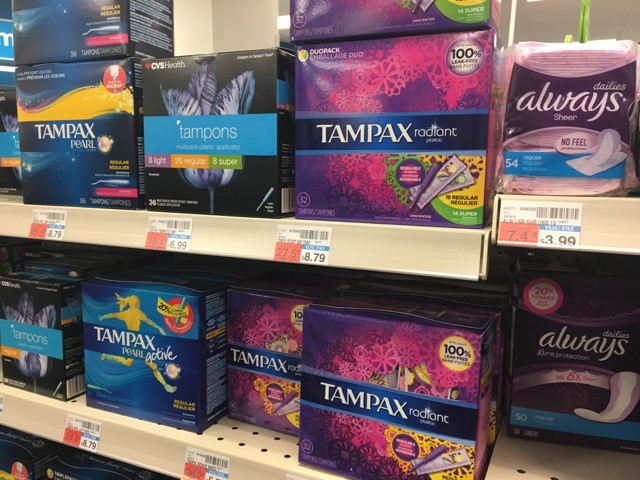Julie Chen, a sophomore at Emory College, wanted to help students get access to free tampons on campus, but she didn’t know how. So she started a petition last January to see how many people would use the supplies. In one week, it received more than 900 responses.
“It wasn’t supposed to go viral,” said Chen, now a junior and the college council vice president of finance. “Seeing all of those names made me really motivated and passionate to keep going on with it.”
The petition received so many responses that Emory launched a pilot program during the fall 2016 semester to provide free tampons. The university changed the tampon dispensers in three locations — a dining hall, the library and one of its academic buildings — to make them free. If enough people use the program, it could become a permanent, university-wide initiative.
“Everyone was really excited about it, and we’ve definitely heard positive responses,” Chen said. “One girl left a comment that said, ‘If men had a need for tampons, they’d be falling out of the sky.’”
Emory is not alone: Students at colleges across the country are demanding free menstrual products. The University of Arizona, Columbia University, Reed College and the University of Minnesota, among others, have launched similar programs on campus, according to Inside Higher Ed.
“Every female has a period in some form, and these supplies aren’t luxury items and should not be treated as luxury items,” said Erin Deal, the infrastructure committee director at the University of Minnesota Student Association. “They’re a necessity. They’re a sanitation item.”
Deal helped expand the university’s decade-old menstrual health program in September after getting her period on campus and having to ask strangers for supplies. She took inspiration from Brown University’s menstrual health program and added tampons and pads in more bathrooms, including gender-neutral bathrooms, at Emory.
Chen and Deal said their programs have been successful, but Columbia University had to cancel its menstrual pilot program after only half a semester because of a lack of interest, according to the Columbia Daily Spectator. Columbia’s health services have continued to provide tampons and pads upon request. (The university did not respond to requests for an interview.)
The cost of supplies is another hindrance to the success of these programs, Deal said. Tampons and pads can cost a person up to $7-$10 every month, amounting to more than $18,000 over a lifetime. In 2015 alone, U.S. consumers spent $3.1 billion on pads, tampons and liners, according to the website Euromonitor.
This expense could be one reason why 86 percent of women said they have been caught without needed supplies in public, according to Free the Tampons, an organization that works to make menstrual products freely accessible in public restrooms.
“Women risk finding themselves in a situation where they lose their dignity and [feel] really humiliated because of the consequences of not having access to what they need,” said Nancy Kramer, founder of Free the Tampons.
Women often feel embarrassed when this happens because of the stigma around menstruation, which prevents people from talking openly about and getting resources for their periods, said Chris Bobel, president of the Society for Menstrual Cycle Research.
“Because it’s a reality that’s shrouded in mystery – the work of the menstrual silence and secrecy – we do menstruators a great disseverance by not paying adequate and non-normalized, non-panicked attention to it,” Bobel said.
The movement to stop menstrual stigma has caught fire in recent years, Kramer said. National Public Radio called 2015 “the year of the period” because so many people, from Olympians to actresses to politicians, talked publicly about periods.
In March, President Barack Obama became the first president to comment on menstruation when he asked why 40 states tax tampons as a luxury item. In July, New York became the 11th state to eliminate the sales tax on menstrual care products. Washington, D.C. and Florida also plan to get rid of the tax.
“I think we’re starting to see a real shift in how people are approaching menstrual care that’s really critical,” said Sarah Christopherson, policy advocacy director at the National Women’s Health Network. “It is really critical to remove the stigma. This is a natural, healthy part of women’s lives and the lives of people with uteruses.”
Girls sometimes miss school because they do not have menstrual products and face this stigma, Free the Tampons founder Kramer said. That’s why New York City passed legislation in July to provide free menstrual products in all public schools, shelters and correctional facilities.
“They realized that students’ attendance actually increased by 2.4 percent after their pilot program,” Kramer said. “That was a pretty staggering statistic for them to realize that, in fact, girls and women stay home from school when they have their menstrual cycle. So it’s well worth the investment.”
Schools and colleges need not only to provide products, but also to have a “menstrual discourse” that openly talks about periods in order to eliminate the stigma, Bobel said.
“Good information is the basis of good decision making, so it’s really important that people have access to knowledge and support so they can indeed make those healthy decisions,” Bobel said. “Products without education is really not attacking the problem.”
Chen said that the Emory menstrual program has already started a conversation on menstrual health.
“Talking to other people, it’s taught me that it’s important for equality purposes,” Chen said. “It’s a good step in the right direction of equality and prioritizing women’s health.”


